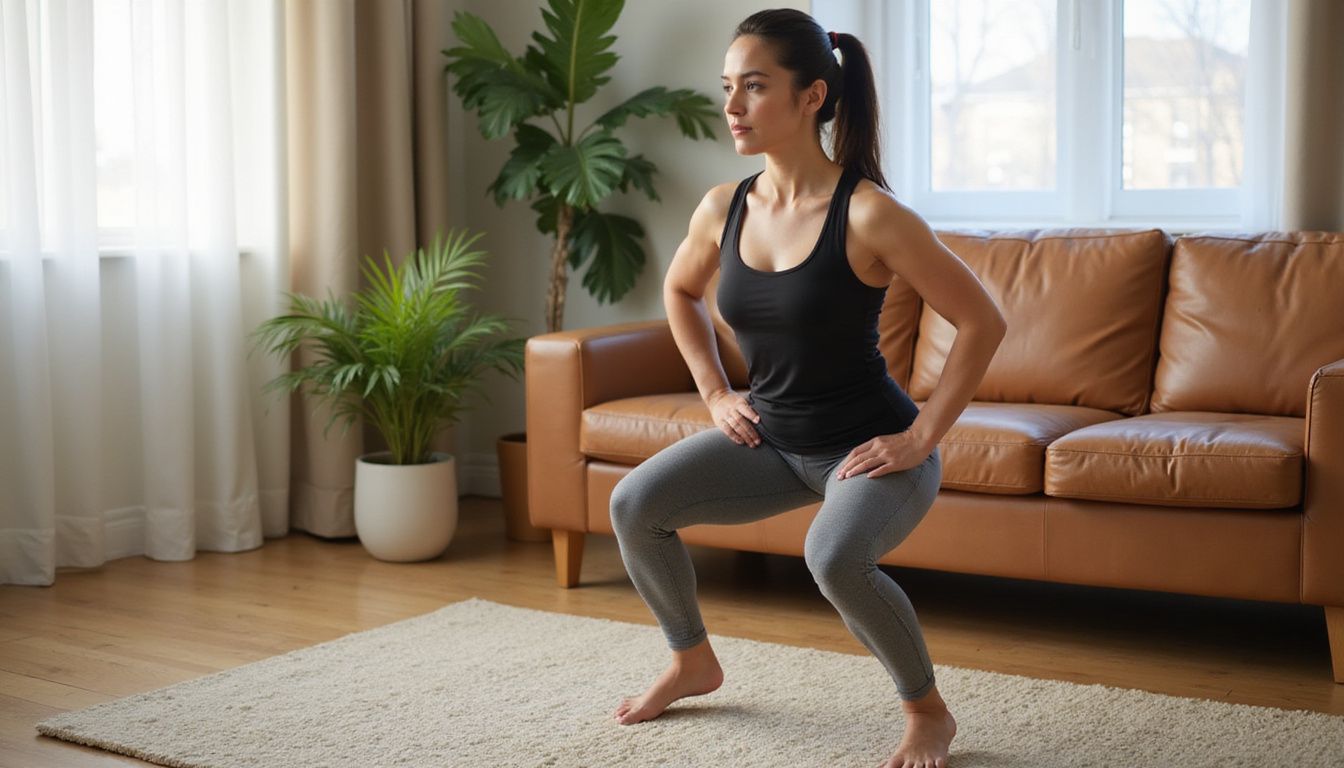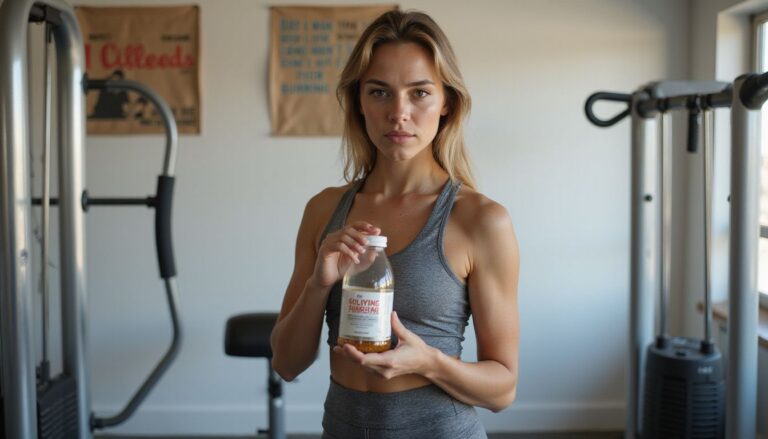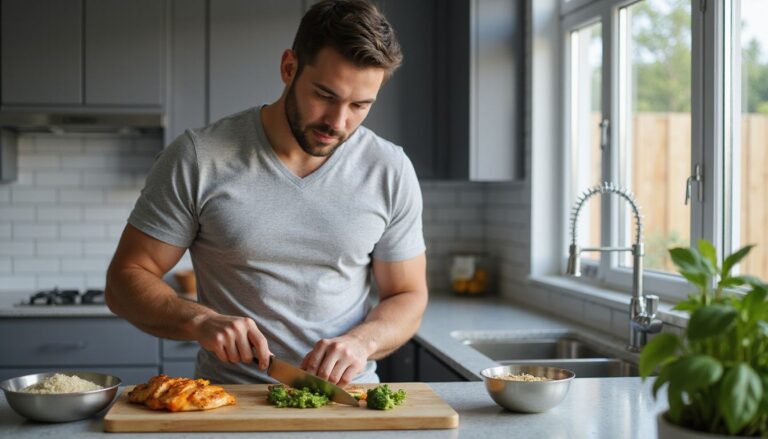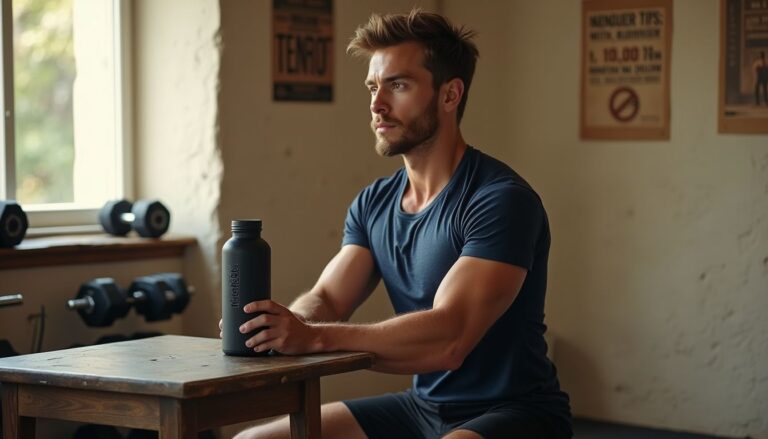Female-Friendly Home Workout: Exercise For Weight Loss And Fat Burn
Our Nutrition Assistant AI Suite will transform your body. You will lose fat, get toned, and build muscle. Gain confidence and optimal health.
You may want to lose weight at home, but crowded gyms, high costs, or tight schedules can block progress. Research shows that a home workout can support fat burn and better health without fancy machines. Simple exercises for weight loss done in your living room can still deliver strong results.
This guide shares clear, female-friendly routines to help you burn fat, build muscle, and stay motivated. Use these steps to shape a plan that fits your day. Start with one small change, then add more as your confidence grows.
Key Takeaways
- Home workouts can save about 800 dollars per year compared with many gym memberships, and they let you train on your schedule (CDC, ACE).
- Combining strength training with cardio, like HIIT or stair running, burns more fat and builds muscle faster than either alone, based on ACE research.
- Effective moves include squats, lunges, jumping jacks, resistance band drills, and HIIT circuits, and most need only bodyweight or a few low-cost items.
- The CDC recommends at least 150 minutes of moderate aerobic activity plus two strength sessions weekly for weight loss and wide health benefits.
- Tracking your plan with tools like MyFitnessPal or NHS Couch to 5K can raise consistency by up to 40 percent, which keeps motivation high.
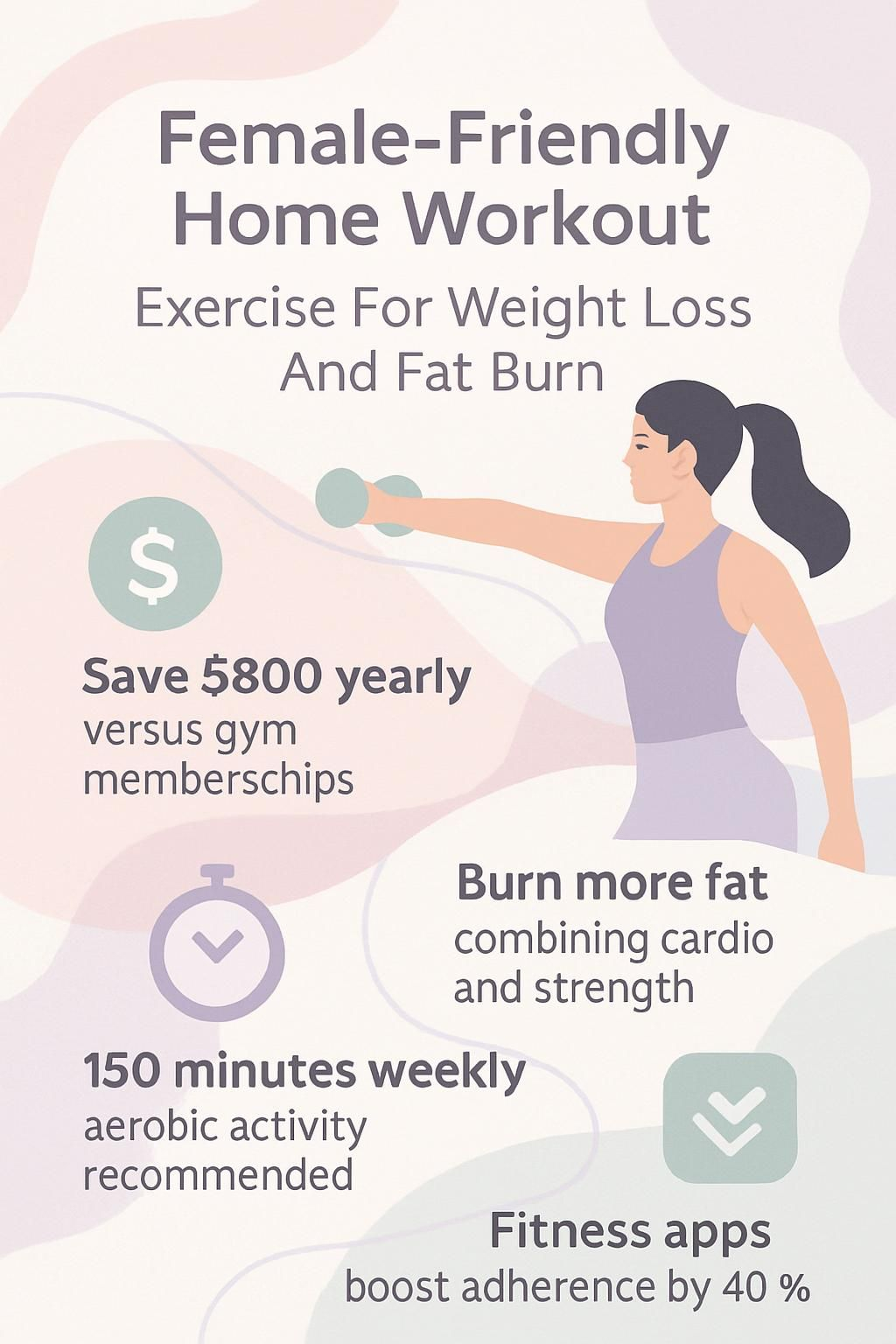
Benefits of Home Workouts for Women
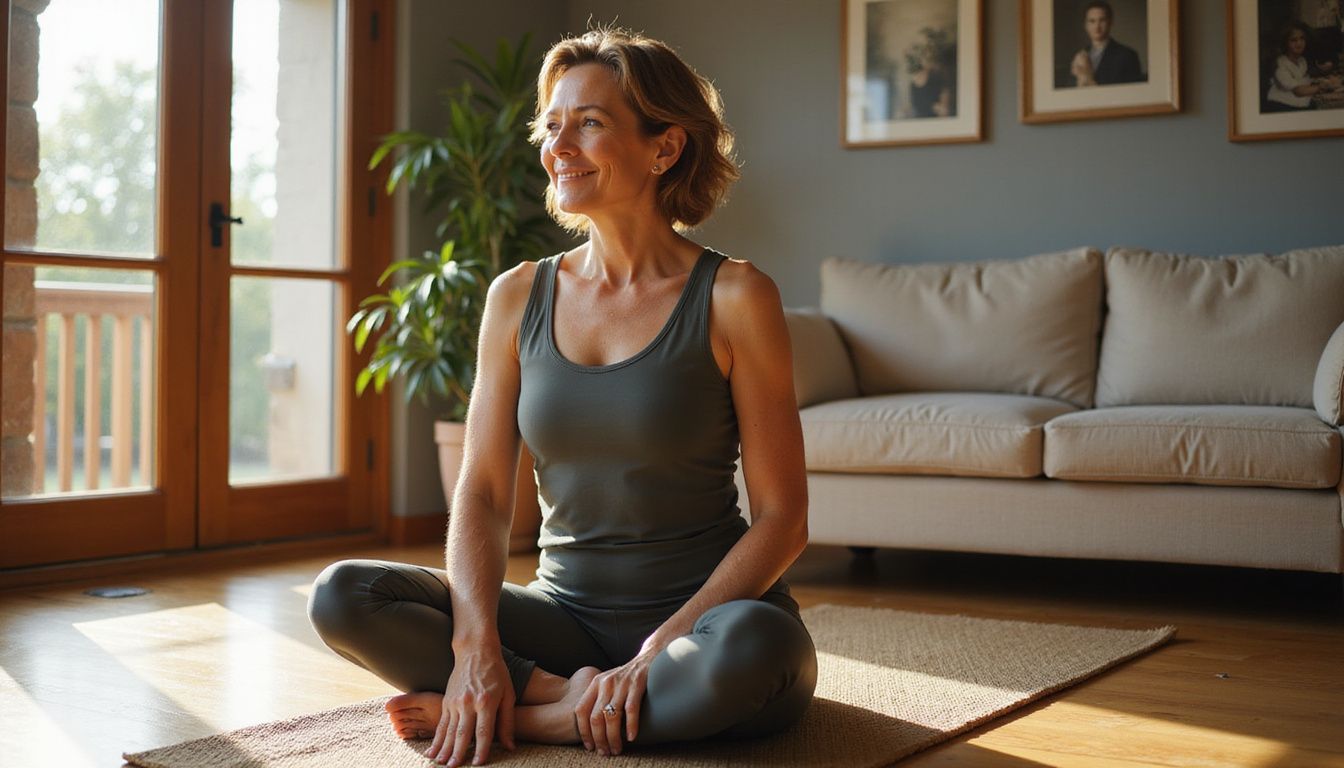
Training at home gives you full control over time and tools. You can pick the best exercises to lose weight, improve fitness, and avoid travel time.
Why are home workouts convenient and flexible for women?
Home sessions fit around work, school, and childcare. Short videos like Couch to Fitness offer 30 minute workouts that you can pause, repeat, and scale to your level.
You can rotate different exercises for weight loss using bodyweight, bands, or a pair of dumbbells. No waiting for machines or dealing with crowded spaces, which saves time and stress.
Plans are easy to adjust as you improve. Start with a full-body workout, then add target days for upper body or lower body. As strength grows, try high-intensity interval training, which mixes hard bursts with short rest.
Setting a routine three times per week or more helps consistency. Regular practice supports long-term weight loss and better day-to-day energy.
How do home workouts save money?
Gym fees in the United States often run 40 to 70 dollars each month, which can top 800 dollars a year. Training at home removes membership costs and travel expenses.
Most plans need only an exercise mat, a resistance band, or a light dumbbell set. These are one-time buys. A sturdy chair, a backpack with books, or water bottles can stand in for weights.
Free videos from well known trainers on YouTube cut class costs. You can also use walking, stair climbing, or simple aerobic exercise at home to raise your heart rate without machines.
Spending less on equipment lets you put money toward nutritious food and other health needs. Saving cash also makes it easier to stick with your plan.
What makes home workouts private and comfortable?
Exercising at home offers privacy and control. No one is watching your form, your weight training skills, or your body composition. Wear what feels good, and choose music that fires you up.
Thick mats lower stress on knees and wrists during squats, lunges, planks, and ab exercises. A mirror can help you check posture while you lift.
Foam rollers ease sore muscles after fat burn sessions. Keep a towel and water nearby to stay comfortable during moderate exercise. A calm home space helps you focus better than a busy fitness center.
What are effective cardiovascular exercises for fat burning?
Cardiovascular exercise raises your heart rate and helps your body burn more calories. Use a few options each week to target body fat and support weight control.
How do jumping jacks help burn fat?
Jumping jacks are a fast way to lift your heart rate, so you burn more calories per minute than many slow activities. This move works your shoulders, legs, glutes, and core at the same time.
Try 30 second rounds inside your home workout routine. Short, quick sets deliver aerobic benefits and a small plyometric effect, which can speed fat loss.
Holding 1 to 3 pound dumbbells makes the move tougher and can raise calorie burn. Regular use supports a calorie deficit, which is needed to lower body fat percentage.
Many trainers add jumping jacks to a fat loss workout because you need only a little space, and the results can feel similar to running or rope skipping.
Can dancing be a good cardio workout?
Dance workouts count as aerobic exercise, and they add fun to your plan. Following a YouTube routine keeps you moving your arms, legs, and chest in rhythm, which raises calorie burn.
Health experts suggest at least 150 minutes of moderate intensity activity each week for heart health and weight loss. Dancing helps you reach that goal while targeting stubborn belly fat.
Pick styles you enjoy, like hip hop or Zumba, to stay consistent. Variety keeps your brain engaged and activates different muscle groups.
How does jumping rope aid in fat loss?
Jumping rope pushes your heart rate up quickly. It often burns more calories per minute than brisk walking or casual cycling.
Ten minutes can burn up to about 130 calories, depending on your size and pace. You can use an actual rope or mimic the motion without equipment.
Exercise physiology research links regular rope work with better fitness and lower obesity risk. Many coaches include jump rope in home routines to speed fat burn and improve coordination.
Is running or jogging on stairs or treadmill effective for fat burn?
Running or jogging on stairs or a treadmill is an efficient way to burn calories. Stair work also builds muscle in your legs and glutes, which raises energy use.
Harvard Medical School reports that a 155 pound person can burn around 372 calories in 30 minutes of running at 6 miles per hour. Adjust speed or incline based on your current fitness.
Intervals with walking, jogging, and running can boost progress. Many women like stair sessions because they mix strength and cardio in one short workout.
What bodyweight exercises build strength and tone muscles?
Bodyweight training lets you build strength and tone at home without machines. Aim for at least two strength days each week for steady change.
How do squats tone your legs and glutes?
Squats target your quads, hamstrings, and glutes. Lowering your body under control fires large muscles, which burns calories and shapes your lower body.
Use a chair for support if you are a beginner. As you get stronger, hold dumbbells or household items to add resistance. Studies show that weighted squats boost muscle growth more than bodyweight alone.
Include squats twice per week for fat burn and definition. This move remains a staple because it is effective and works in small spaces.
Why are lunges good for strength?
Lunges train your quads, glutes, and hamstrings together. They also challenge balance, which activates your core muscles. Add a dumbbell or a bag of rice to make the set tougher.
Research shows that compound moves, like lunges, build muscle and raise calorie use^1. Include them on strength days to improve lower body power.
I started with bodyweight lunges in my living room, using cans as makeshift weights. Four weeks later, climbing stairs felt easier and my legs felt steadier.
Lunges fit most plans since they take little room and deliver strong results for shaping your legs.
^1 American Council on Exercise (ACE): “Lower Body Strengthening: Why Compound Movements Work Best,” 2020
What benefits do planks offer for toning?
Planks strengthen your core, which includes your abs, lower back, and the muscles around your shoulders. You can drop to your knees to make the move easier.
A stability ball raises the challenge and improves balance. Plank jacks add a cardio burst, which can help fat burn while you hold a solid position.
Static holds like planks support better posture and train many muscles at once. Learning basic movement terms and cues can help you focus on safe plank form for better results.
How can beginners do push-ups safely?
Core strength from planks supports your push-up form. Start with knee push-ups or wall push-ups to reduce strain while you learn proper hand, elbow, and back alignment.
Begin with 5 to 8 reps per set. Add reps only when the set feels strong and controlled. Hand release push-ups can teach full range motion with a safer rhythm.
Quality beats speed. Keep your body in a straight line from head to knees or toes. Use a mirror to check form. If you have joint pain or health concerns, talk to your doctor before starting or changing your exercises.
Strength Training at Home
Strength training at home uses simple tools, like resistance bands and dumbbells, to build muscle and support weight loss and health. These basics can match many gym moves if you use steady form.
How to use resistance bands for strength training?
Resistance bands are low cost and portable. They help you train every major muscle group while you adjust tension easily.
- Attach a band to a closed door or anchor for rows and presses. This setup works like a cable machine.
- Stand on the band for squats and hold the handles at shoulder level. The band adds resistance as you stand up.
- Loop the band behind your back for a lying triceps extension. Press upward to target the back of your arms.
- Step on the band and perform a bicep curl. Keep elbows close and move with control.
- Try band lunges with the band under your front foot and handles in your hands. This makes the lunge more challenging.
- Move to a thicker band as you get stronger. Higher tension lets you progress without heavy weights.
- Bands are cheaper than many weights and take little space, which helps your budget.
- Even astronauts use bands in space to maintain muscle, which shows how effective they can be.
Mix band work with dumbbell exercises for a balanced plan. The next section outlines starter dumbbell moves.
What dumbbell exercises are effective for beginners?
Once you are comfortable with bands, add dumbbells for more variety and strength. Start light, then build up as form improves.
- Bicep curls: Hold a dumbbell in each hand. Curl slowly with elbows close to your sides. Try 3 to 6 sets of 6 to 12 reps.
- Deadlifts: Use light dumbbells or heavy water bottles. Keep feet hip width apart. Hinge at the hips and lower weights toward your shins.
- Weighted squats: Hold a dumbbell at your chest. Sit back into the squat. Keep knees tracking over your feet.
- Tricep extensions: Hold one dumbbell overhead with both hands. Lower behind your head, then lift to the start. Aim for 3 to 6 sets of 6 to 12 reps.
- Chest presses: Lie on the floor or a bench. Press dumbbells straight up, then lower with control.
- Lunges: Hold a dumbbell in each hand. Step forward, bend both knees, and push back to stand.
- Starting with lighter loads builds confidence and reduces injury risk. Add reps or weight only as form stays clean.
- Water bottles can work until you buy dumbbells, which makes this plan easier to start.
- These moves train several muscles at once, which supports a smart diet plan and better health.
- Keep technique tight on every squat, lunge, and press to get the most from each set.
How to add weights safely to basic movements?
Adding weight makes simple moves more effective, but safety comes first. Good technique protects your joints and boosts results.
- Start with light loads, such as 2 to 5 pound dumbbells or filled water bottles.
- Practice correct form without weight first. Build stable patterns for squats, lunges, and push-ups.
- Use a weight vest or hold small dumbbells for squat jumps, jumping jacks, or a lunge to raise intensity carefully.
- Increase weight slowly, no more than 2 to 5 pounds at a time.
- Use backpacks with books or heavy bottles if you do not have traditional weights.
- Brace your core during lifts to support your spine and reduce injury risk.
- Track how you feel, and cut the load if you notice pain or pinching.
- Leave at least one day of rest between weight days so muscles can recover.
- Watch clear YouTube tutorials for technique tips on burpees and lunges.
- Form comes first, since proper alignment protects joints and improves fat burn and muscle tone.
Flexibility and Mind-Body Workouts
Flexibility and mind-body sessions can build strength, lower stress, and support healthy eating habits. Many women use short YouTube classes to stretch and reset on lighter days.
How does yoga improve strength and relaxation?
Yoga builds strength with poses like bridge, downward dog, and chair pose. These positions train legs, core, and arms using only your bodyweight.
Breathing and gentle focus support calm moods. Stretching reduces tension, which helps your body feel rested. In my experience, a 20 minute session lowers stress and lifts my energy for hours.
Studies link regular yoga with lower cortisol, the stress hormone. This can aid recovery, sleep, and appetite control.
What benefits does Pilates provide for core and control?
Pilates targets deep abs, back, and hips using precise, controlled motions. It improves posture, balance, and muscle tone.
You only need a mat and simple props, like a band or light weights. Research shows steady Pilates practice improves body awareness and movement efficiency.
After a few weeks, many people feel steadier and report less low back discomfort. Doing Pilates three times per week helped my midsection feel firmer and more supported.
What are effective HIIT routines for fat loss?
HIIT means high-intensity interval training. You work hard for a short burst, rest briefly, then repeat. This structure can boost fat burn in less time than steady cardio.
What is an example HIIT circuit combining cardio, strength, and core?
Try this 6 step home HIIT circuit. It blends cardio, strength, and core work in one quick session.
- Do each move for 30 seconds at a strong pace.
- Jumping jacks, hold 1 to 3 pound dumbbells if safe to raise intensity.
- Burpees, add a push-up to increase strength demand.
- Squat jumps, hold light weights if you can keep great form.
- Skater jumps, move side to side to train hips and thighs.
- Plank jacks, jump your feet wide then narrow to fire your core and shoulders.
- High knees, pump your arms to drive up your heart rate.
- Rest 30 to 60 seconds between rounds. Keep transitions short for a tougher workout.
- Do one round on busy days, then build to two or three rounds as fitness improves.
- Push to feel breathless, but keep technique clean to stay safe.
I track rounds and reps in an app, which helps me see progress week to week.
Why are short, intense bursts of exercise beneficial?
Short, hard intervals raise calorie burn during the session and after. This afterburn effect is called excess post exercise oxygen consumption, or EPOC.
Studies suggest HIIT can reduce fat in less time than steady cardio. A 2018 Journal of Obesity review found that HIIT may keep metabolism elevated for up to a day or two after training.
Busy schedule, no problem. A focused 20 minute session can match the calorie burn of longer moderate workouts if you push the pace safely.
How to create a sustainable workout routine?
A routine that fits your life is easier to keep. Small steps build confidence, which leads to steady change.
Why start slow and progress gradually?
Gradual progress lowers injury risk and protects your joints and heart. Start with lighter loads and simpler versions, such as knee push-ups or chair squats, then increase sets and reps as form improves.
Aim for 3 to 6 sets of 6 to 12 reps as a general range once you are ready. Moving too fast often causes fatigue and sloppy form, which can stall fat burn and weight loss.
Building in small steps supports health and makes your plan easier to follow month after month.
How to maintain workout consistency?
Make daily movement a habit. Create a small workout zone at home and set a fixed time for training.
Place your shoes, mat, or bands where you will see them. Visual cues can raise adherence by as much as 40 percent. Use phone alarms or a calendar to lock in your schedule.
Focus on consistency, not perfection. One missed session will not erase gains. Celebrate small wins, and track your week in an app or simple journal.
Support matters. Online friends or active groups often double the chance of sticking with new routines over 12 weeks compared with going solo, based on a 2018 study in the American Journal of Preventive Medicine.
Why include rest and recovery days?
Muscle repair happens while you rest. These breaks fix tiny tears from training, which prevents injuries and soreness.
Skipping recovery can cause overtraining, slower progress, and low motivation. A 2021 study found that planned rest improved both strength and endurance in women training at home.
Use active recovery, like stretching, easy yoga, or walking. This keeps you moving while your muscles heal.
What nutrition tips support your workout goals?
Food choices drive energy, recovery, and fat loss. Pair smart meals with training to see stronger results from your plan.
Why is a balanced diet important for weight loss?
A balanced plate gives your body fuel to train and rebuild. Choose lean protein, whole grains, fruits, and vegetables. These foods keep you full longer and calm cravings.
Research shows that combining better nutrition with regular exercise can double weight loss compared with exercise alone. Protein after workouts helps repair muscles, and complex carbs provide steady energy.
This mix supports fat burn and makes your routine easier to maintain.
How much water should you drink during workouts?
Drink about 7 to 10 ounces of water every 10 to 20 minutes during exercise. Longer sessions may need more, especially if you sweat a lot.
Carry a bottle with markings to keep track. Sip water during the day, and add lemon, berries, or cucumber for taste. Unsweetened seltzer and herbal tea also count.
Most women need roughly 64 to 96 ounces of total fluids daily, including what you drink during workouts.
How to track progress and stay motivated?
Tracking shows what is working and keeps you engaged. Simple tools or apps can turn small wins into lasting habits.
What are the best fitness apps or journals to use?
The right app or journal makes it easier to log workouts, set reminders, and watch your progress.
- NHS Couch to 5K App: A free nine week plan that guides you from walking to running a 5K, with motivational podcasts. Available on the App Store and Google Play.
- NHS Active 10 App: Encourages regular brisk walks and tracks time at a heart raising pace to support fat loss.
- Couch to Fitness: Structured, progressive home videos for all levels if you want clear guidance without leaving home.
- MyFitnessPal: Log workouts, track calories, and monitor nutrition. It syncs with many trackers and supports a balanced eating plan.
- FitNotes: A simple workout journal for sets, reps, and exercises that keeps your strength plan organized.
- Google Fit: Tracks steps and heart points, and syncs with other health apps to encourage consistency.
- JEFIT Workout Planner: Offers plans, instructions, and progress charts for bodyweight, strength, or HIIT sessions at home.
Pick one tool and use it daily for two weeks. That streak alone can boost momentum.
How to celebrate small milestones effectively?
Mark each success, such as finishing a streak or hitting a new rep best. Choose non food rewards like new workout socks, a relaxing bath, or a favorite show.
Write down progress in a journal. Seeing your wins on paper builds confidence and keeps your weight loss journey positive.
What common mistakes should you avoid during home workouts?
A few common errors can slow your progress or raise injury risk. Fixing them now will help your results and confidence.
Why should you never skip warm-ups and cool-downs?
Skipping warm-ups raises the chance of strains. A short warm-up increases blood flow and body temperature so muscles and joints move better.
Cool-downs help bring your heart rate down and ease tight muscles. Stretching after training often reduces next day stiffness. People who include both steps recover faster and stay more flexible.
How can overtraining harm your progress?
Overtraining drains energy and lowers performance. You might feel tired even during easy sessions. Injury risk goes up if you push hard without rest.
Poor sleep can follow, which can affect hunger hormones like leptin and ghrelin. That shift can lead to stronger cravings and slower fat loss.
Plan regular rest days. They repair muscles and prevent burnout so you can stay consistent.
Why is maintaining proper form crucial?
Good technique makes exercise safer and more effective. It reduces strain on joints and helps each rep work the right muscles.
Many injuries during high-intensity work or band and dumbbell sessions come from sloppy form. Beginners benefit most by mastering basic technique before adding speed or weight.
For example, a squat with a straight back and steady knees targets your legs and glutes better than a quick, rounded version. Posture first, then intensity.
Conclusion
A female-friendly home workout for weight loss and fat burn can be simple and flexible. A few basics, such as dumbbells, resistance bands, or a jump rope, are enough to start and grow your plan.
Research from ACE suggests combining cardio with strength training improves fat loss and builds lean muscle. The CDC recommends 150 minutes of moderate aerobic exercise weekly plus two strength sessions for health and steady progress.
Warm up before you train, cool down after, and schedule rest. Track small wins, and adjust your exercises for weight loss as your fitness improves. If you have medical concerns, consult a healthcare professional before changing your routine.
…
[1] American Council on Exercise (ACE). Benefits of combining strength training and cardio for weight loss.
[2] Centers for Disease Control and Prevention (CDC). Physical Activity for a Healthy Weight: The importance of consistency.
FAQs
1. What are the best female-friendly home exercises for weight loss and fat burn?
Effective options include brisk walking in place, bodyweight squats, push-ups, lunges, and interval training routines. Research shows that combining aerobic activities with resistance movements increases calorie use and supports fat reduction.
2. How often should women perform these workouts to see results?
Studies suggest that engaging in moderate-intensity exercise at least five days per week leads to noticeable changes in body composition within eight to twelve weeks. Consistency is key for sustained progress.
3. Are there specific nutrition guidelines to follow with a home workout plan?
A balanced diet rich in lean proteins, whole grains, fruits, and vegetables supports muscle repair and energy needs. Data from clinical trials indicate that pairing regular exercise with a calorie deficit enhances fat loss.
4. Can beginners start these workouts without equipment?
Yes; most movements such as squats, planks, and step-ups require no equipment. Many women report feeling more confident after starting with simple routines at home. Over time, adding light weights or resistance bands can increase challenge and results.
Summary: Female-friendly home workouts that combine aerobic and resistance movements help with weight loss and fat reduction. Consistent exercise paired with balanced nutrition supports progress. Beginners can start without equipment and gradually increase intensity as they gain confidence.

